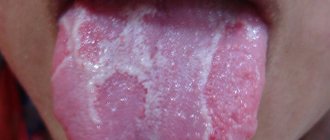What happens during vomiting?
Vomiting is a protective reflex in which the contents of the stomach and initial parts of the intestines are returned through the mouth.
As a rule, it is preceded by nausea. It is caused by irritation of the receptors of the gastrointestinal tract (GIT) or a direct effect on the vomiting center, which is located in the brain stem. The gag reflex is realized by contracting the diaphragm, intercostal and abdominal muscles with the simultaneous opening of the lower esophageal sphincter, which normally prevents the return of food from the stomach into the esophagus. At the same time, the epiglottis closes and breathing stops, which prevents vomit from entering the respiratory tract.
As a result, the contents of the stomach, including enzymes and fluid, leave the body through the oral cavity. Also, due to the activation of the autonomic nervous system, salivation increases and sweating occurs. All this leads to loss of fluid - dehydration, which becomes a serious problem with prolonged vomiting.
First aid
Uncontrollable, profuse and frequently repeated vomiting can quickly lead to dehydration and the development of serious pathological changes in the child’s body. Therefore, parents of infants need to know what to do in such a situation.
If a child vomits, it is necessary to protect him from getting vomit into the respiratory tract. The baby should be kept in an elevated position (at an angle of 30°), and the head should be turned to the side. If you experience nausea during feeding, you should delay eating for at least two hours.
If vomiting occurs once and there are no other alarming symptoms, it is enough to monitor the child’s condition. Repeated, excessive vomiting in combination with other symptoms requires medical attention. Before the doctor arrives, you need to take measures to prevent dehydration: give the baby 1-2 teaspoons of water every 3-5 minutes. At the age of 1–3 years, you can increase the portion to 2–3 teaspoons. It is better to alternate water with Regidron solution.
If vomiting is non-stop, accompanied by increased excitability, impaired consciousness, abdominal pain, lethargy, apathy, rare urination, convulsions, and also if it appears after ingesting suspicious food or injury, you need to call emergency help. Even if parents know what to do in such cases, they should not give the baby medications until specialists arrive. This can, at best, change the clinical picture, and at worst, cause complications. Do not rinse the stomach if the child is unconscious. It is strictly not recommended to refuse scheduled examinations, even if the condition improves after a few days.
Causes of vomiting in a child
Vomiting is one of the most common symptoms in children and can be associated with a wide variety of diseases and disorders of the gastrointestinal tract, nervous system, functional disorders and other reasons.
Intestinal infection in children
The most common cause of vomiting is gastrointestinal infections (video 1). As a rule, they occur when eating contaminated food or water, as well as when personal hygiene is not observed. Clinical manifestations may vary significantly depending on the specific disease.
The most common types of intestinal infections in children are:
- Intestinal flu (rotavirus infection), caused by viruses from the Reoviridae family. It is transmitted through contaminated water and through direct contact with a sick person.
- Viral gastroenteritis. In addition to rotaviruses, inflammation of the stomach and small intestine can also be caused by other viruses: adenovirus, norovirus, astroviruses.
- Salmonellosis, caused by Salmonella bacteria. Typical sources of infection are eggs, meat, poultry, milk and products prepared on their basis, for example, confectionery creams.
- Dysentery (shigellosis). The causative agent is bacteria of the genus Shigella. It can be transmitted through water, food (most often milk and dairy products), as well as through household items.
- Eschirichiosis (travelers' diarrhea), caused by bacteria from the genus Escherichia, often by Escherichia coli (E. Coli). Transmission factors include: water, dairy products, prepared meat products, drinks, as well as household items, such as toys.
- Listeroiosis. The causative agent is Listeria monocytogenes. Most often detected in semi-finished meat products and ready-to-eat meat products (canned food, sausages), soft cheeses and cold smoked fish products.
Infectious lesions of the gastrointestinal tract in children, in addition to vomiting, also cause other symptoms, such as diarrhea, fever, abdominal pain, slow weight gain, etc.
Video 1. What to do if you have an intestinal infection.
Diseases of the digestive organs
Another common cause of vomiting in childhood is diseases of the gastrointestinal tract. Most often this is:
- Gastritis is inflammation of the gastric mucosa.
- Duodenitis is inflammation of the duodenum.
- Pancreatitis is inflammation of the pancreas.
- Cholecystitis is inflammation of the gallbladder.
- Intestinal obstruction.
In infancy, constant regurgitation may be associated with pyloric stenosis and pyloric spasm. Pyloric stenosis is a structural deformation of the pylorus of the stomach, which prevents food from passing into the duodenum. With pylorospasm, similar changes occur, but they are temporary, since they are caused by increased tone of the stomach muscles.
What symptoms indicate problems with the gastrointestinal tract?
Common symptoms that suggest the development of gastrointestinal diseases in children are:
- Pain in various areas of the abdomen that occurs immediately after eating or after some time.
- Bowel disorders: diarrhea or constipation.
- Pathological impurities in feces, undigested food particles.
- Flatulence, belching sour or rotten.
Food poisoning in a child
Food poisoning, as well as infectious diseases of the gastrointestinal tract, are caused by eating contaminated food. However, in food poisoning, the key role is played not by the bacteria themselves, but by their metabolic products, released into the nutrient medium in which these bacteria have been present for a long time. Thus, a large amount of bacterial toxins enters the child’s body at once, which causes vomiting and other symptoms of poisoning.
Vomiting may be a sign of poisoning. Photo by Mac DeStroir from Pexels
The previously mentioned salmonella, as well as the bacteria Clostridium botulinum, which causes botulism, can release large amounts of toxins into products. The cause of the development of botulism is most often low-quality canned food, pickles, as well as insufficiently thermally processed meat and fish.
Important! Vomiting is one of the first reactions to eating foods unsuitable for food, for example, poisonous mushrooms, berries or raw meat.
Acute appendicitis
Acute appendicitis is an acute inflammation of the appendix (the vermiform appendix of the cecum). It is one of the most common surgical pathologies of the abdominal cavity.
Often, the first signs of appendicitis in childhood are constant acute pain in the abdomen, which later moves to the right iliac region, and an increase in body temperature up to 37.5 ° C (Fig. 1). In addition, nausea and vomiting once or twice often occur.
Acute appendicitis requires immediate surgical intervention - removal of the inflamed appendix of the intestine.
Figure 1. Classic symptoms of an “acute abdomen” that often accompany acute appendicitis. Source: Adobe Stock
Foreign body in the esophagus
A common cause of vomiting in childhood is the ingestion of foreign bodies, often small toys or their parts, for example, construction parts. Moreover, it is paroxysmal in nature, is in no way connected with meals, and the gag reflex may not be accompanied by evacuation of the stomach contents at all. In such cases, seeking medical help is indicated.
Acetone vomiting in children
Cyclic acetonemic vomiting syndrome is a set of manifestations that arise as a result of a sharp increase in the level of ketone bodies in the child’s blood plasma.
This condition may be the result of constitutional abnormalities (neuroarthritic diathesis) or prolonged fasting, the body's reaction in the postoperative period, or the manifestation of certain diseases and conditions: severe infections or endocrine pathologies (diabetes mellitus).
A characteristic feature of acetone vomiting in children is the cyclical nature of episodes that occur at regular intervals - from 15 to 60 minutes. Between them, the child, as a rule, feels satisfactory. Also noted: the smell of acetone from the mouth, increased body temperature and diarrhea.
Neurological disorders in children
The gag reflex can be provoked by a direct effect on the medulla oblongata, the part of the brain stem in which the so-called vomiting center is located. This occurs with concussion due to traumatic brain injury, with infectious lesions of the central nervous system (meningitis, encephalitis) and increased intracranial pressure due to hydrocephalus.
Neurotic or psychogenic vomiting in a child
In children of preschool and early school age, vomiting can be caused by strong emotional experiences, fear or stress. Associated phenomena are often surges in blood pressure, increased sweating, pallor, dizziness and general weakness.
Vomiting due to motion sickness
Children are more prone to kinetosis or motion sickness. It manifests itself with nausea and vomiting against a background of monotonous, prolonged fluctuations and occurs during long journeys by car, on buses and trains, or on a sea vessel. This pathology is also accompanied by dizziness, general weakness, pallor and sweating (video 2).
The mechanism for the development of motion sickness is the prolonged irritation of the vestibular apparatus located in the inner ear. Normally, he perceives the position of the body in space. However, when traffic is moving, the information received visually is often perceived by the brain as a static position, although some movement occurs. This heterogeneity of information received is what causes motion sickness.
Video 2. What to do if a child gets motion sickness.
Symptoms of intoxication in the presence of vomiting
In case of poisoning, infectious and inflammatory diseases, vomiting is accompanied by the so-called intoxication syndrome.
This is a set of symptoms caused by the entry into the blood of various toxins, tissue breakdown products, etc. Intoxication syndrome, in addition to possible nausea and vomiting, includes:
- General weakness, malaise and increased anxiety.
- Increased body temperature to 37-40°C and increased sweating.
- Loss of appetite.
- Headache, which at a young age is manifested by constant, sometimes monotonous crying.
What should I do?
You should not feed your baby immediately after vomiting. We need to put him to bed and give him fluids in small increments until the doctor arrives. If the child’s condition is not critical, there is no need to urgently hospitalize him; he should undergo blood and urine tests for high sugar levels or the presence of acetone, undergo an ultrasound of the internal organs, and a computed tomography scan of the brain.
In mild cases, bed rest and a special diet are indicated. The doctor prescribes the necessary medications.
In any case, when a child vomits, including in the morning, you should carefully consider his condition and provide first aid. If you experience frequent vomiting with clear suspicious symptoms, you should immediately seek medical help.
What to do in case of vomiting?
The actions of parents depend on the causes of development and characteristics of the vomit. If vomiting is one-time and is not accompanied by other symptoms, no special action is required from parents. Otherwise, it is recommended to follow these recommendations:
- Constantly monitor the child. The baby should be held vertically in your arms; older children should be placed on their side or brought into a semi-sitting position. This will prevent you from inhaling vomit.
- After an attack of vomiting, rinse the baby's mouth with clean water using a bulb or a large syringe. Older children should be helped to rinse their mouths.
- Avoid using any medications on your own without knowing the cause of vomiting. At best, the pills will simply come out along with a new portion of vomit; at worst, they can cause harm and complicate diagnosis.
Excessive vomiting in children is accompanied by dehydration due to significant loss of fluid along with vomit. Therefore, it is important to restore losses with the help of mineral waters, special solutions, and in their absence - ordinary water.
If possible, the child should be given something to drink when vomiting. Photo: AndrewLozovyi / Depositphotos
How can I help you?
There is no need to overfeed your child or force him to eat. Especially if it is heavy flour, fried or fatty foods. Eating this way in the morning is not healthy even for an adult. It is better to have light oatmeal or muesli with milk for breakfast.
For nervous vomiting, ask your child about relationships with classmates or the teacher. During this period, there is no need to scold your child for bad grades in class or for behavior. Timely intervention and psychological support will help him adapt faster. After an attack of vomiting, you should give the child a glass of clean water. The baby's condition will improve significantly.
The cause of vomiting in a child of any age is often a viral respiratory disease. He suffers from a dry cough in the morning and in the evening, which can cause stomach cramps and vomiting. Also, the cause of vomiting during a virus can be a profuse runny nose. Mucous secretions accumulate in the nasopharynx, causing a gag reflex.
In this case, you need to give the child antiviral herbal teas, rinse the nose, and do inhalations using essential oils or other means that alleviate the condition.
In what cases should you consult a doctor?
If vomiting is persistent and accompanied by other alarming symptoms, you should seek medical help as soon as possible. You should call a doctor at home if:
- Vomiting appeared immediately after a traumatic brain injury.
- Vomiting is accompanied by an increase in body temperature.
- The vomit is bright green or yellow-green in color and contains blood or brown vomit that resembles coffee grounds.
- Vomiting is accompanied by severe abdominal pain.
- Rashes appeared on the child's body.
- There is a suspicion of ingestion of foreign bodies.
- There is a suspicion of ingestion of toxic substances.
There are signs of severe dehydration: lack of urination for more than 3 hours, dry skin, tongue and mucous membranes, crying without tears, pathological drowsiness and irritability, “recession” of the abdomen and cheeks.
Rash and vomiting are a reason to call a doctor. Photo: natulrich/Depositphotos
What other serious illnesses could such a symptom indicate?
For various forms of gastritis: alimentary gastritis, acute gastroduodenitis or gastritis due to burns of the mucous membrane (for example, if the child has swallowed harmful substances such as acids or alkalis).
Vomiting due to exacerbation of gastritis is usually accompanied by belching with an unpleasant taste, malaise, gas formation and restless sleep.
Pancreatic disease is another possible cause. In most cases, this is pancreatitis. In this case, you can notice bile in the vomit, and the child vomits frequently and profusely. Pancreatitis can be caused by many reasons, but most often it is due to errors in diet.
Cholecystitis and biliary dyskinesia are other possible causes of vomiting. In this case, vomiting may be accompanied by loss of appetite, pain in the abdomen and in the area under the ribs on the right, bitterness in the mouth, and constipation. The reasons for this can be either poor nutrition or bacteria, microorganisms or other diseases.
Finally, the cause of vomiting can be disturbances in the functioning of the central nervous system: increased intracranial pressure, possibly malignant and benign brain tumors. In this case, in addition to vomiting, the child may experience loss of coordination, headaches, dizziness, and loss of consciousness.
Treatment of vomiting in children
The general treatment of vomiting depends on its origin. For example, in case of food poisoning, the main role in first aid is played by gastric lavage as soon as possible and the use of enterosorbents (activated carbon).
Treatment of vomiting, in addition to eliminating the main cause of its occurrence, includes restoring water and electrolyte balance. This is especially important in case of severe, prolonged and frequently repeated vomiting, due to which the body loses a large amount of fluid.
To compensate for the loss of fluid, ordinary mineral waters, slightly sweetened tea or special solutions are used, powders for the preparation of which can be purchased at the pharmacy. In severe cases, intravenous drip therapy is also used.
If it is impossible to determine the cause of vomiting or eliminate it, the use of antiemetics is indicated. Depending on the situation, the following can be used:
- Anticholinergics (scopolamine).
- Neuroleptics (chlorpromazine, haloperidol).
- H1 blockers (clemastine, promethazine).
- Dopamine receptor blockers (metoclopramide and domperidone).
What should you not do if you are vomiting?
Under no circumstances is it recommended to resort to the following actions:
- Do gastric lavage yourself (especially if the child is unconscious).
- Give your baby antispasmodics and antiemetics without the doctor's permission.
- Give any antibiotics without identifying the cause of the disease.
- Refuse to visit the doctor again if the child’s condition has returned to normal.
Vomiting without fever can be either a reaction to the food eaten or indicate some kind of disease. Therefore, if there is frequent emptying of the stomach and other alarming symptoms, you should immediately call an ambulance. The doctor will determine the true cause of vomiting and prescribe treatment. Otherwise, dehydration of the body and exacerbation of gastrointestinal diseases may occur.
Sources
- Novikova V.P., Gurova M.M., Khavkin A.I. Functional nausea and vomiting in children. Questions of children's dietetics. 2020; 18(4): 36–44
- Dubrovskaya M.I., Mukhina Yu.G., Shumilov P.V., & Volodina I.I. (2007). Regurgitation and vomiting syndrome in children of the first year of life: differential diagnosis and management tactics. Pediatrics. Journal named after G.N. Speransky, 86 (6), 18.
- Forbes D., Fairbrother S. Cyclic nausea and vomiting in childhood // Aust. Fam. Physician. - 2008. - 37(1-2).
- Boles R., Powers A., Adams K. Cyclic Vomiting Syndrome Plus // J. Child Neuro. - 2006. - 21(3).
- Muminova D.A. “Nosoological structure of recurrent vomiting in children” FORCIPE, no. Application, 2021, pp. 269-270.









